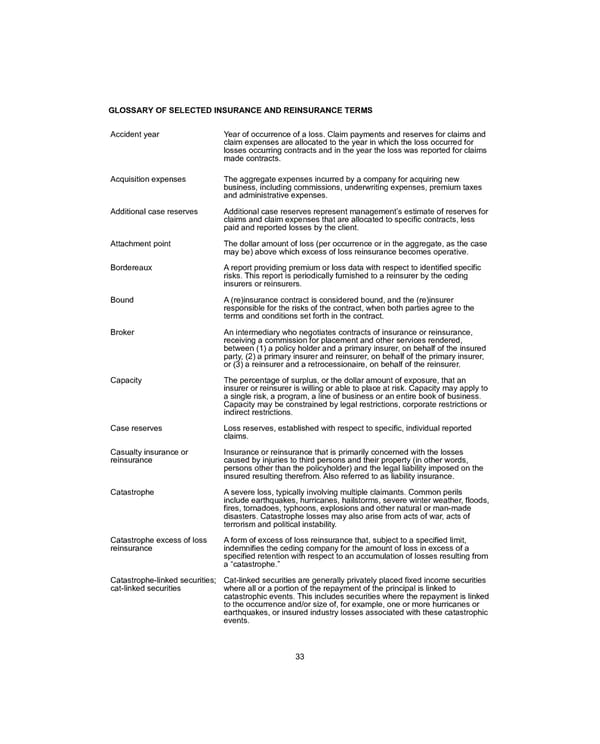GLOSSARY OF SELECTED INSURANCE AND REINSURANCE TERMS Accident year Year of occurrence of a loss. Claim payments and reserves for claims and claim expenses are allocated to the year in which the loss occurred for losses occurring contracts and in the year the loss was reported for claims made contracts. Acquisition expenses The aggregate expenses incurred by a company for acquiring new business, including commissions, underwriting expenses, premium taxes and administrative expenses. Additional case reserves Additional case reserves represent management’s estimate of reserves for claims and claim expenses that are allocated to specific contracts, less paid and reported losses by the client. Attachment point The dollar amount of loss (per occurrence or in the aggregate, as the case may be) above which excess of loss reinsurance becomes operative. Bordereaux A report providing premium or loss data with respect to identified specific risks. This report is periodically furnished to a reinsurer by the ceding insurers or reinsurers. Bound A (re)insurance contract is considered bound, and the (re)insurer responsible for the risks of the contract, when both parties agree to the terms and conditions set forth in the contract. Broker An intermediary who negotiates contracts of insurance or reinsurance, receiving a commission for placement and other services rendered, between (1) a policy holder and a primary insurer, on behalf of the insured party, (2) a primary insurer and reinsurer, on behalf of the primary insurer, or (3) a reinsurer and a retrocessionaire, on behalf of the reinsurer. Capacity The percentage of surplus, or the dollar amount of exposure, that an insurer or reinsurer is willing or able to place at risk. Capacity may apply to a single risk, a program, a line of business or an entire book of business. Capacity may be constrained by legal restrictions, corporate restrictions or indirect restrictions. Case reserves Loss reserves, established with respect to specific, individual reported claims. Casualty insurance or reinsurance Insurance or reinsurance that is primarily concerned with the losses caused by injuries to third persons and their property (in other words, persons other than the policyholder) and the legal liability imposed on the insured resulting therefrom. Also referred to as liability insurance. Catastrophe A severe loss, typically involving multiple claimants. Common perils include earthquakes, hurricanes, hailstorms, severe winter weather, floods, fires, tornadoes, typhoons, explosions and other natural or man-made disasters. Catastrophe losses may also arise from acts of war, acts of terrorism and political instability. Catastrophe excess of loss reinsurance A form of excess of loss reinsurance that, subject to a specified limit, indemnifies the ceding company for the amount of loss in excess of a specified retention with respect to an accumulation of losses resulting from a “catastrophe.” Catastrophe-linked securities; cat-linked securities Cat-linked securities are generally privately placed fixed income securities where all or a portion of the repayment of the principal is linked to catastrophic events. This includes securities where the repayment is linked to the occurrence and/or size of, for example, one or more hurricanes or earthquakes, or insured industry losses associated with these catastrophic events. 33
 2021 Annual Report Page 48 Page 50
2021 Annual Report Page 48 Page 50